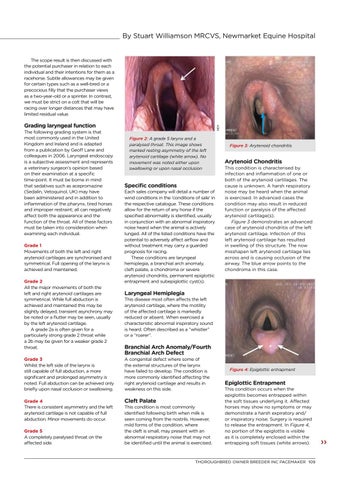By Stuart Williamson MRCVS, Newmarket Equine Hospital
The scope result is then discussed with the potential purchaser in relation to each individual and their intentions for them as a racehorse. Subtle allowances may be given for certain types such as a well-bred or a precocious filly that the purchaser views as a two-year-old or a sprinter. In contrast, we must be strict on a colt that will be racing over longer distances that may have limited residual value.
The following grading system is that most commonly used in the United Kingdom and Ireland and is adapted from a publication by Geoff Lane and colleagues in 2006. Laryngeal endoscopy is a subjective assessment and represents a veterinary surgeon’s opinion based on their examination at a specific time-point. It must be borne in mind that sedatives such as acepromazine (Sedalin, Vetoquinol, UK) may have been administered and in addition to inflammation of the pharynx, tired horses and improper restraint; all can negatively affect both the appearance and the function of the throat. All of these factors must be taken into consideration when examining each individual. Grade 1 Movements of both the left and right arytenoid cartilages are synchronised and symmetrical. Full opening of the larynx is achieved and maintained. Grade 2 All the major movements of both the left and right arytenoid cartilages are symmetrical. While full abduction is achieved and maintained this may be slightly delayed, transient asynchrony may be noted or a flutter may be seen, usually by the left arytenoid cartilage. A grade 2a is often given for a particularly strong grade 2 throat while a 2b may be given for a weaker grade 2 throat. Grade 3 Whilst the left side of the larynx is still capable of full abduction, a more significant and prolonged asymmetry is noted. Full abduction can be achieved only briefly upon nasal occlusion or swallowing. Grade 4 There is consistent asymmetry and the left arytenoid cartilage is not capable of full abduction. Minor movements do occur. Grade 5 A completely paralysed throat on the affected side.
Sep_169_Vets_Forum.indd 109
NEH
Grading laryngeal function
Figure 2: A grade 5 larynx and a paralysed throat. This image shows marked resting asymmetry of the left arytenoid cartilage (white arrow). No movement was noted either upon swallowing or upon nasal occlusion
Specific conditions
Each sales company will detail a number of wind conditions in the ‘conditions of sale’ in the respective catalogue. These conditions allow for the return of any horse if the specified abnormality is identified, usually in conjunction with an abnormal inspiratory noise heard when the animal is actively lunged. All of the listed conditions have the potential to adversely affect airflow and without treatment may carry a guarded prognosis for racing. These conditions are laryngeal hemiplegia, a branchial arch anomaly, cleft palate, a chondroma or severe arytenoid chondritis, permanent epiglottic entrapment and subepiglottic cyst(s).
Figure 3: Arytenoid chondritis
Arytenoid Chondritis
This condition is characterised by infection and inflammation of one or both of the arytenoid cartilages. The cause is unknown. A harsh respiratory noise may be heard when the animal is exercised. In advanced cases the condition may also result in reduced function or paralysis of the affected arytenoid cartilage(s). Figure 3 demonstrates an advanced case of arytenoid chondritis of the left arytenoid cartilage. Infection of this left arytenoid cartilage has resulted in swelling of this structure. The now misshapen left arytenoid cartilage lies across and is causing occlusion of the airway. The blue arrow points to the chondroma in this case.
Laryngeal Hemiplegia
This disease most often affects the left arytenoid cartilage, where the motility of the affected cartilage is markedly reduced or absent. When exercised a characteristic abnormal inspiratory sound is heard. Often described as a “whistler” or a “roarer”.
Branchial Arch Anomaly/Fourth Branchial Arch Defect A congenital defect where some of the external structures of the larynx have failed to develop. The condition is more commonly identified affecting the right arytenoid cartilage and results in weakness on this side.
Cleft Palate
This condition is most commonly identified following birth when milk is seen coming from the nostrils. However, mild forms of the condition, where the cleft is small, may present with an abnormal respiratory noise that may not be identified until the animal is exercised.
Figure 4: Epiglottic entrapment
Epiglottic Entrapment
This condition occurs when the epiglottis becomes entrapped within the soft tissues underlying it. Affected horses may show no symptoms or may demonstrate a harsh expiratory and/ or inspiratory noise. Surgery is required to release the entrapment. In Figure 4, no portion of the epiglottis is visible as it is completely enclosed within the entrapping soft tissues (white arrows).
››
THOROUGHBRED OWNER BREEDER INC PACEMAKER 109
24/08/2018 16:09
